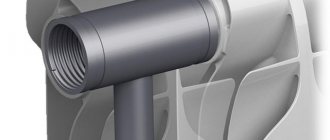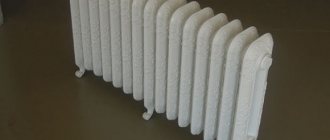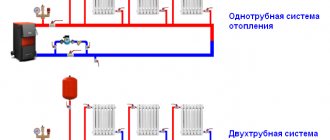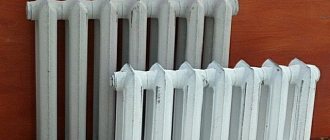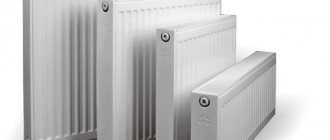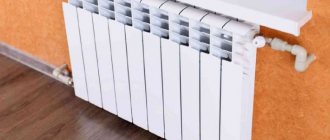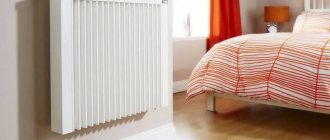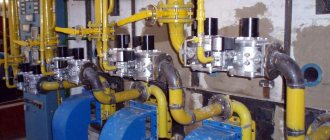Data preparation
To get an accurate result, the following parameters should be taken into account:
- climatic features of the region in which the building is located (humidity level, temperature fluctuations);
- building parameters (material used for construction, thickness and height of walls, number of external walls);
- size and types of windows to premises (residential, non-residential).
When calculating bimetallic heating radiators, 2 main values are taken as a basis: the thermal power of the battery section and the heat loss of the room. It must be remembered that most often the thermal power indicated by manufacturers in the technical data sheet of the product is the maximum value obtained under ideal conditions. The actual power of the battery installed indoors will be lower, so recalculation is done to obtain accurate data.
The most accurate calculation option
From the above calculations, we saw that none of them is perfectly accurate, because... Even for identical rooms, the results, albeit slightly, are still different.
If you need maximum calculation accuracy, use the following method. It takes into account many coefficients that can affect heating efficiency and other significant indicators.
In general, the calculation formula is as follows:
T=100 W/m2 *A *B * C * D * E * F * G * S,
- where T is the total amount of heat required to heat the room in question;
- S – area of the heated room.
The remaining coefficients require more detailed study. Thus, coefficient A takes into account the characteristics of the glazing of the room.
Features of room glazing
The values are as follows:
- 1.27 for rooms whose windows are glazed with just two glasses;
- 1.0 – for rooms with windows equipped with double glazing;
- 0.85 – if the windows have triple glazing.
Coefficient B takes into account the insulation features of the walls of the room.
Features of insulation of room walls
The dependency is as follows:
- if the insulation is low-effective, the coefficient is taken equal to 1.27;
- with good insulation (for example, if the walls are laid with 2 bricks or are purposefully insulated with a high-quality heat insulator), a coefficient of 1.0 is used;
- with a high level of insulation - 0.85.
Coefficient C indicates the ratio of the total area of window openings and the floor surface in the room.
The ratio of the total area of window openings and the floor surface in the room
The dependency looks like this:
- with a ratio of 50%, coefficient C is taken as 1.2;
- if the ratio is 40%, use a coefficient equal to 1.1;
- with a ratio of 30%, the coefficient value is reduced to 1.0;
- in the case of an even smaller percentage, coefficients equal to 0.9 (for 20%) and 0.8 (for 10%) are used.
Coefficient D indicates the average temperature during the coldest period of the year.
Heat distribution in a room when using radiators
The dependency looks like this:
- if the temperature is -35 and below, the coefficient is taken equal to 1.5;
- at temperatures up to -25 degrees, a value of 1.3 is used;
- if the temperature does not drop below -20 degrees, the calculation is carried out with a coefficient of 1.1;
- residents of regions where the temperature does not drop below -15 should use a coefficient of 0.9;
- if the temperature in winter does not fall below -10, count with a coefficient of 0.7.
The E coefficient indicates the number of external walls.
Number of external walls
If there is only one external wall, use a factor of 1.1. With two walls, increase it to 1.2; with three – up to 1.3; if there are 4 external walls, use a coefficient of 1.4.
The F coefficient takes into account the features of the room above. The dependency is:
- if there is an unheated attic space above, the coefficient is taken equal to 1.0;
- if the attic is heated - 0.9;
- if the neighbor above is a heated living room, the coefficient can be reduced to 0.8.
And the last coefficient of the formula - G - takes into account the height of the room.
Room height
The order is as follows:
- in rooms with ceilings 2.5 m high, the calculation is carried out using a coefficient of 1.0;
- if the room has a 3-meter ceiling, the coefficient is increased to 1.05;
- with a ceiling height of 3.5 m, count with a factor of 1.1;
- rooms with a 4-meter ceiling are calculated with a coefficient of 1.15;
- when calculating the number of battery sections for heating a room 4.5 m high, increase the coefficient to 1.2.
This calculation takes into account almost all existing nuances and allows you to determine the required number of sections of the heating unit with the smallest error. In conclusion, all you have to do is divide the calculated figure by the heat transfer of one section of the battery (check in the attached data sheet) and, of course, round the found number up to the nearest integer value.
Heating radiator calculator
For convenience, all these parameters are included in a special calculator for calculating heating radiators. It is enough to indicate all the requested parameters - and clicking on the “CALCULATE” button will immediately give the desired result:
Energy Saving TipsEnergy Saving Tips
Happy calculations!
The simplest method
In this case, you will need to recalculate the number of installed batteries and rely on this data when replacing elements of the heating system. The difference between the heat transfer of bimetallic and cast iron batteries is not too big. In addition, over time, the heat transfer of the new radiator will decrease due to natural reasons (contamination of the internal surfaces of the battery), so if the old elements of the heating system coped with their task, the room was warm, you can use this data.
However, in order to reduce the cost of materials and eliminate the risk of the room freezing, it is worth using formulas that will allow you to calculate the sections quite accurately.
calculation of the number of sections of bimetallic radiators
Calculation by area
For each region of the country, there are SNiP standards, which stipulate the minimum power value of the heating device for each square meter of room area. To calculate the exact value according to this standard, you must determine the area of the existing room (a). To do this, the width of the room is multiplied by its length.
The power per square meter is taken into account. Most often it is 100 W.
Having determined the area of the room, the data must be multiplied by 100. The result is divided by the power of one section of the bimetallic radiator (b). This value must be looked at in the technical specifications of the device - depending on the model, the numbers may differ.
A ready-made formula into which you should substitute your own values: (a*100): b= required quantity.
Let's look at an example. Calculation for a room with an area of 20 m², while the power of one section of the selected radiator is 180 W.
We substitute the required values into the formula: (20*100)/180 = 11.1.
However, this formula for calculating heating by area can only be used when calculating values for a room whose ceiling height is less than 3 m. In addition, this method does not take into account heat loss through windows, and the thickness and quality of wall insulation are also not considered. To make the calculation more accurate, for the second and subsequent windows in the room you need to add 2 to 3 additional radiator sections to the final figure.
calculation of sections of bimetallic heating radiators by area
Calculation instructions
There are people who do not know how to calculate the thermal power of a heating radiator correctly. But there is nothing complicated about it. When installing a heating system, it is necessary to achieve the maximum combination of operating efficiency and economy. A few tips will be helpful for inexperienced people:
- If the room has average conditions, then it is necessary to calculate the battery power from 90 to 120 W per square meter of the room. The average statistical conditions are the presence of one door and a wooden window, while the ceiling height does not exceed 3 meters. The coolant temperature fluctuates around 70°C.
- If a room has two or more windows, then a separate battery must be installed under each one. This way you can prevent your windows from fogging up.
- If the height of the room is greater or less than the standard, then it is necessary to take this into account and increase or decrease the power in direct proportion to the height of the shelf.
- If double-glazed windows are installed, then from standard calculations you need to subtract from 15 to 20%.
- Rooms located in corners require more heat. Therefore, 2 batteries should be installed in them, and the power should be increased by 40%. The same actions should be done in rooms located on the north side, since they are more susceptible to cold winds. Weather conditions and temperature conditions are taken into account in the calculations.
- The design features of the battery are also important. If the coolant in the system moves from bottom to top in sections, then the power should be increased by 10%.
- The power must be increased by 15% if the coolant temperature is 10°C less than normal, and reduced if it is more.
- When the inlet and outlet for the coolant on the battery are located on one side, the number of sections should not exceed ten, since the last ribs will not have time to heat up enough.
- You also need to take into account the type of radiator, since the required power is different for each type.
When performing calculations, it is not recommended to do them for the whole house at once . It is better to do each room separately; there is no need to rush during such an important process. After increasing by one section, the load on the boiler decreases, so the additional fin is a good indicator.
We recommend: Calculation of an expansion tank for closed and open heating
Calculating battery power for personal use is not difficult. Enough with the basic rules of mathematics and physics. But to obtain the appropriate permit, you must invite a licensed specialist.
Calculation by volume
Calculation of the number of sections of bimetallic radiators using this method is carried out, taking into account not only the area, but also the height of the room.
Having received the exact volume, calculations are made. Power is calculated in m³. SNiP standards for this value are 41 W.
For example, we take the same values, but add the height of the walls - it will be 2.7 cm.
Let's find out the volume of the room (we multiply the already calculated area by the height of the walls): 20 * 2.7 = 54 m³.
Next, we determine the required battery power (we multiply the volume of the room by SNiP standards): 54*41 = 2214.
The next step is to calculate the exact number of sections based on this value (we divide the total power by the power of one section): 2214/180 = 12.3.
The final result differs from that obtained when calculating by area, so the method taking into account the volume of the room allows you to get a more accurate result.
Heat transfer analysis of radiator sections
Despite the external similarity, the technical characteristics of radiators of the same type can differ significantly. The power of the section is affected by the type of material used to make the battery, the size of the section, the design of the device, and the thickness of the walls.
To simplify preliminary calculations, you can use the average number of radiator sections per 1 m², derived by SNiP: • cast iron can heat approximately 1.5 m²; • aluminum battery – 1.9 m²; • bimetallic – 1.8 m².
How can you use this data? From them you can calculate the approximate number of sections, knowing only the area of the room. To do this, the area of the room is divided by the specified indicator.
For a room of 20 m² you will need 11 sections (20/1.8 = 11.1). The result approximately coincides with that obtained by calculating the area of the room.
Calculation using this method can be carried out at the stage of drawing up an approximate estimate - this will help to roughly determine the costs of organizing the heating system. And more accurate formulas can be used when a specific radiator model is selected.
Is a bimetallic radiator profitable and to what extent?
To confirm high heat transfer rates, data from tables is often provided.
| Material from which the heating radiator is made | Heat transfer indicators (W/m*K) |
| Cast iron | 53 |
| Steel | 66 |
| Aluminum | 230 |
| Bimetal | 380 |
Such information, which compares favorably with its “brothers,” is often used for advertising as reliable data on the heat transfer of various water heating systems. Although the fact that the heat transfer of bimetallic radiators is higher than that of their analogues is well known to everyone even without data from the reference book, can the difference really be up to 40%?
If you look at the table from the reference book, you can see that the biggest difference in heat transfer is 10%, but not 40%.
What does the heat transfer factor depend on?
Before trying to evaluate or compare the heat transfer efficiency of a bimetallic radiator, let us recall what the thermal power of a heating system depends on:
- The thermal pressure of the radiator plays the following role - the greater the difference between the air temperature and the average surface temperature data, the stronger the thermal sweat that is transferred to the room air.
- Thermal conductivity of the material from which the radiator is made - the higher the thermal conductivity index, the smaller the difference between the outer wall of the radiator and the temperature of the medium will be.
- Dimensions of the heating system and number of sections.
- Coolant pressure and temperature.
Please note that in those heating systems that use water, 98% of the heat transfer from the walls to the air is carried out by convention, so in addition to the size, the shape is also very important. But in practice, it is quite difficult to take into account all configurations, so only linear accounting of dimensions is used.
Thermal pressure is the first criterion, which is calculated as the difference between half sums and the air temperature in the room. There is even a certain correction factor that helps clarify the heat transfer of the radiator when calculating the system power for the room.
Based on the table of correction factors, we can conclude that the data on the heat transfer of a bimetallic radiator will correspond to reality only during the first hour of operation of the heating system, since such data are only possible when there is a temperature difference in a cold room. Typically, coolants rarely heat up above 85 degrees, which means that maximum heat transfer is available at room temperature of 15 degrees.
The thermal conductivity of the radiator wall material is the second criterion in which a radiator made of bimetal is significantly inferior to aluminum designs. The design of the bimetal heating section shown in the diagram clearly shows that the walls consist of aluminum and steel. Even if the wall thickness is the same under similar conditions, the bimetallic housing cannot be better in terms of heat transfer than an aluminum heating system.
Typically, the dimensions of these two heating systems are the same and are designed for installation under a window sill. Note that the structure made of aluminum and bimetal takes up more space than steel or cast iron models. For this reason, heat transfer can be stronger than with standard calculations based solely on the properties of metals - heat capacity and thermal conductivity. Now it remains to figure out the pressure and temperature of the coolant.
Ideal conditions for using bimetallic radiators
In many ways, the design and circuit of the aluminum bimetallic system are similar. Inside the section there is a main channel through which the heated coolant will move. The dimensions and shape of the channel will correspond to the cross-section of the supply pipe, which means that the liquid will not be subject to additional turbulence and there will be no local overheating spots.
From the tabular data that we have already relied on above, it becomes clear that these two types of radiator structures are designed for high pressure and high coolant temperature. In this case, all the advantages are obvious. To begin with, the temperature difference increases, and instead of the usual 70 degrees, the difference may already be 100. For example, at the entrance to the heating system, the pressure and temperature of the coolant are 18 bar and 110 degrees, and for steam systems it is all 120 degrees. This means that we have a correction factor for heat transfer efficiency of 1.2, which is equal to 20%.
And also, the higher the coolant pressure, the higher the heat transfer coefficient and heat transfer from liquid to metal will be. Due to the increase in value due to increased pressure, the final data may increase by up to 7%. When summing up all the conditions, it turns out that bimetallic radiators are perfect for heating high-rise buildings.
Although all manufacturers give the same service life and guarantees for two types of heat exchangers, in fact, only bimetal can work for a long time. Even with various additives, hot water will still act destructively on aluminum. Is it a different matter with alloy steel with additives in the form of nickel and manganese, the service life of which can be equal to 15 years.
Calculation of the number of sections taking into account climatic conditions
The manufacturer indicates the thermal power value of one radiator section under optimal conditions. Climatic conditions, system pressure, boiler power and other parameters can significantly reduce its efficiency.
Therefore, when calculating, these parameters should be taken into account:
- If the room is corner, then the value calculated using any of the formulas should be multiplied by 1.3.
- For every second and subsequent windows you need to add 100 W, and for a door - 200 W.
- Each region has its own additional coefficient.
- When calculating the number of sections for installation in a private house, the resulting value is multiplied by 1.5. This is due to the presence of an unheated attic and the external walls of the building.
Thermal power
In the room, heating devices are placed on the outer wall under the window opening. Thanks to this, the heat emitted by the device is distributed optimally. The cold air flow coming from the windows is blocked by the heated flow coming upward from the radiator.
Cast iron batteries
Cast iron analogues have the following advantages:
- have a long service life;
- have a high level of strength;
- they are resistant to corrosion;
- Excellent for use in utility systems operating on low-quality coolant.
- At the moment, manufacturers produce cast iron batteries (their price is higher than simple analogues), which have an improved appearance, thanks to the use of new technologies for casting their housings.
Disadvantages of products: enormous mass and thermal inertia.
The lower table states how many kW is in a cast iron radiator, based on its model.
| Radiator model | Thermal power of one section in Watts |
| MS-140/M-2 | 160 |
| MS-140/M-300 | 117 |
| MS-90 | 130 |
| T-90/M | 127 |
Note! In order to heat a room with an area of 15 m2, the power, in other words, kW of a cast iron radiator, must be at least 1.5. In other words, the battery must consist of 10-12 sections.
Aluminum radiators
Aluminum products have enormous thermal power than their cast iron counterparts. When asked how many kW is in one section of an aluminum radiator, experts answer that it reaches 0.185-0.2 kW. As a result, for the standard level of heating of a fifteen-meter room, 9-10 sections of aluminum sections will be enough.
The advantages of such devices:
- a light weight;
- aesthetic design;
- high level of heat transfer;
- You can control the temperature yourself using thermostatic valves.
But aluminum products do not have the same strength as their cast iron counterparts, for example a 2 kW oil radiator. Based on this, they are sensitive to surges in operating pressure in the system, water hammer, and excessively high temperature of the coolant.
Note! When the pH level (acidity) of the water is high, aluminum releases large amounts of hydrogen. This has a very bad effect on our health. Based on this, such devices should be used in a heating system in which the coolant is neutral in acidity.
Bimetallic products
Before you find out how many kW there are in 1 section of a bimetallic radiator, you should take into account that such batteries have similar performance parameters to their aluminum counterparts. But they do not have any disadvantages that are typical for them.
This event was determined by the design of the devices.
- They are made up of bronze or steel pipes through which coolant flows.
- The tubes are hidden in an aluminum plate housing. As a result, the water circulating inside does not interact with the aluminum of the case.
- Based on this, the acidic and mechanical characteristics of the coolant do not in any way affect the operation and condition of the device.
Thanks to the steel pipes, the device has greater strength. External fins made of aluminum provide increased heat transfer. When trying to determine how many kW is in a steel radiator, keep in mind that bimetal has the highest heat transfer - about 0.2 kW per fin.
Battery power recalculation
In order to obtain the real, and not specified in the technical specifications for the heating device, power of the heating radiator section, it is necessary to make a recalculation, taking into account the existing external conditions.
To do this, first determine the temperature pressure of the heating system. If the supply turns out to be +70°C, and the output is 60°C, while the desired temperature maintained in the room should be about 23°C, it is necessary to calculate the system delta.
To do this, use the formula: the outlet temperature (60) is added to the inlet temperature (70), the resulting value is divided by 2, and the room temperature is subtracted (23). The result will be a temperature difference (42°C).
The desired value - delta - will be equal to 42°C. Using the table, they find out the coefficient (0.51), which is multiplied by the power specified by the manufacturer. They obtain the real power that the section will produce under given conditions.
| Delta | Coef. | Delta | Coef. | Delta | Coef. | Delta | Coef. | Delta | Coef. |
| 40 | 0,48 | 47 | 0,60 | 54 | 0,71 | 61 | 0,84 | 68 | 0,96 |
| 41 | 0,50 | 48 | 0,61 | 55 | 0,73 | 62 | 0,85 | 69 | 0,98 |
| 42 | 0,51 | 49 | 0,65 | 56 | 0,75 | 63 | 0,87 | 70 | 1 |
| 43 | 0,53 | 50 | 0,66 | 57 | 0,77 | 64 | 0,89 | 71 | 1,02 |
| 44 | 0,55 | 51 | 0,68 | 58 | 0,78 | 65 | 0,91 | 72 | 1,04 |
| 45 | 0,53 | 52 | 0,70 | 59 | 0,80 | 66 | 0,93 | 73 | 1,06 |
| 46 | 0,58 | 53 | 0,71 | 60 | 0,82 | 67 | 0,94 | 74/75 | 1,07/1,09 |
Calculation stages
It is necessary to calculate the heating parameters of a house in several stages:
- calculation of heat loss at home;
- selection of temperature conditions;
- selection of heating radiators by power;
- hydraulic calculation of the system;
- boiler selection.
The table will help you understand what power radiator is needed for your room.
Heat loss calculation
The thermal engineering part of the calculation is performed on the basis of the following initial data:
- thermal conductivity of all materials used in the construction of a private house;
- geometric dimensions of all building elements.
The heat load on the heating system in this case is determined by the formula: Mk = 1.2 x Tp, where
Tp - total heat loss of the building;
Mk - boiler power;
1.2 - safety factor (20%).
For individual buildings, heating calculations can be made using a simplified method: the total area of the premises (including corridors and other non-residential premises) is multiplied by the specific climatic power, and the resulting product is divided by 10.
The value of the specific climatic power depends on the construction site and is equal to:
- for central regions of Russia - 1.2 - 1.5 kW;
- for the south of the country - 0.7 - 0.9 kW;
- for the north - 1.5 - 2.0 kW.
A simplified methodology allows you to calculate heating without resorting to the expensive help of design organizations.
Temperature conditions and selection of radiators
The mode is determined based on the temperature of the coolant (most often it is water) at the outlet of the heating boiler, the water returned to the boiler, as well as the indoor air temperature.
The optimal regime, according to European standards, is the ratio 75/65/20.
To select heating radiators, before installing them, you should first calculate the volume of each room. For each region of our country, the required amount of thermal energy per cubic meter of space has been established. For example, for the European part of the country this figure is 40 W.
To determine the amount of heat for a specific room, you need to multiply its specific value by cubic capacity and increase the resulting result by 20% (multiply by 1.2). Based on the obtained figure, the required number of heating devices is calculated. The manufacturer indicates their power.
For example, each fin of a standard aluminum radiator has a power of 150 W (at a coolant temperature of 70°C). To determine the required number of radiators, you need to divide the amount of thermal energy required by the power of one heating element.
Hydraulic calculation
There are special programs for hydraulic calculations.
One of the most expensive stages of construction is the installation of the pipeline. A hydraulic calculation of the heating system of a private house is needed to determine the diameters of the pipes, the volume of the expansion tank and the correct selection of the circulation pump. The result of the hydraulic calculation is the following parameters:
- Coolant flow in general;
- Loss of heat carrier pressure in the system;
- Pressure loss from the pump (boiler) to each heating device.
How to determine coolant flow? To do this, you need to multiply its specific heat capacity (for water this figure is 4.19 kJ/kg * deg. C) and the temperature difference at the outlet and inlet, then divide the total power of the heating system by the result obtained.
The diameter of the pipe is selected based on the following condition: the speed of water in the pipeline should not exceed 1.5 m/s. Otherwise the system will make noise. But there is also a lower speed limit - 0.25 m/s. Pipeline installation requires an assessment of these parameters.
If this condition is neglected, airing of the pipes may occur. With correctly selected sections, a circulation pump built into the boiler is sufficient for the functioning of the heating system.
The pressure loss for each section is calculated as the product of the specific friction loss (indicated by the pipe manufacturer) and the length of the pipeline section. In the factory specifications they are also indicated for each fitting.
Choosing a boiler and a little economics
The boiler is selected depending on the degree of availability of a particular type of fuel. If gas is supplied to the house, there is no point in purchasing solid fuel or electric. If you need to organize hot water supply, then the boiler is not selected based on heating power: in such cases, they choose to install double-circuit devices with a power of at least 23 kW. With lower productivity, they will provide only one water collection point.
Additional recommendations
To give batteries an aesthetic appearance, they are often masked with special screens or curtains. In this case, the heating device reduces heat transfer, and when calculating the required number of sections, another 10% is added to the final result. Since most modern radiator models have a certain number of sections, it is not always possible to select batteries taking into account the calculations performed. In this case, it is recommended to purchase a product whose number of sections is as close as possible to the desired one or slightly more than the calculated value.
